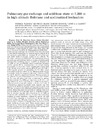Identificador persistente para citar o vincular este elemento:
https://accedacris.ulpgc.es/jspui/handle/10553/6561
| Título: | Pulmonary gas exchange and acid-base state at 5,260 m in high-altitude Bolivians and acclimatized lowlanders | Autores/as: | Wagner, P.D. Araoz, M. Boushel, R. Calbet, JAL Jessen, Birguitte Radegran, Goran Spielvogel, Hilde Sondergaard, H. Wagner, Harrieth Saltin, Bengt |
Clasificación UNESCO: | 241106 Fisiología del ejercicio | Palabras clave: | Hypoxia Cardiac output VO2max Altitude Exercise |
Fecha de publicación: | 2002 | Publicación seriada: | Journal of Applied Physiology | Resumen: | Pulmonary gas exchange and acid-base state were compared in nine Danish lowlanders (L) acclimatized to 5,260 m for 9 wk and seven native Bolivian residents (N) of La Paz (altitude 3,600-4,100 m) brought acutely to this altitude. We evaluated normalcy of arterial pH and assessed pulmonary gas exchange and acid-base balance at rest and during peak exercise when breathing room air and 55% O2. Despite 9 wk at 5,260 m and considerable renal bicarbonate excretion (arterial plasma HCO3- concentration = 15.1 meq/l), resting arterial pH in L was 7.48 +/- 0.007 (significantly greater than 7.40). On the other hand, arterial pH in N was only 7.43 +/- 0.004 (despite arterial O2 saturation of 77%) after ascent from 3,600-4,100 to 5,260 m in 2 h. Maximal power output was similar in the two groups breathing air, whereas on 55% O2 only L showed a significant increase. During exercise in air, arterial PCO2 was 8 Torr lower in L than in N (P < 0.001), yet PO2 was the same such that, at maximal O2 uptake, alveolar-arterial PO2 difference was lower in N (5.3 +/- 1.3 Torr) than in L (10.5 +/- 0.8 Torr), P = 0.004. Calculated O2 diffusing capacity was 40% higher in N than in L and, if referenced to maximal hyperoxic work, capacity was 73% greater in N. Buffering of lactic acid was greater in N, with 20% less increase in base deficit per millimole per liter rise in lactate. These data show in L persistent alkalosis even after 9 wk at 5,260 m. In N, the data show 1) insignificant reduction in exercise capacity when breathing air at 5,260 m compared with breathing 55% O2; 2) very little ventilatory response to acute hypoxemia (judged by arterial pH and arterial PCO2 responses to hyperoxia); 3) during exercise, greater pulmonary diffusing capacity than in L, allowing maintenance of arterial PO2 despite lower ventilation; and 4) better buffering of lactic acid. These results support and extend similar observations concerning adaptation in lung function in these and other high-altitude native groups previously performed at much lower altitudes. | URI: | https://accedacris.ulpgc.es/handle/10553/6561 | ISSN: | 8750-7587 | DOI: | 10.1152/japplphysiol.00093.2001 | Fuente: | Journal Of Applied Physiology[ISSN 8750-7587],v. 92 (4), p. 1393-1400 |
| Colección: | Artículos |
Vista completa
Citas SCOPUSTM
84
actualizado el 08-jun-2025
Citas de WEB OF SCIENCETM
Citations
78
actualizado el 08-jun-2025
Visitas
76
actualizado el 18-may-2024
Descargas
319
actualizado el 18-may-2024
Google ScholarTM
Verifica
Altmetric
Comparte
Exporta metadatos
Este elemento está sujeto a una licencia Licencia Creative Commons

